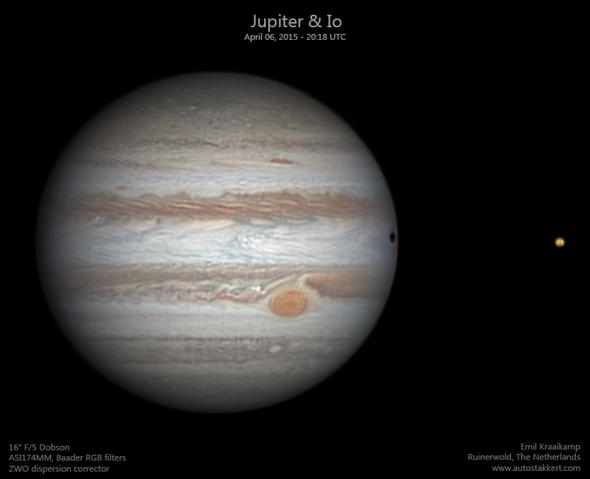Right now, two planets dominate the sky after sunset: Venus in the west, and Jupiter high to the south. Both are amazingly bright, clearly ruling their areas of the sky. Both planets are also in parts of their orbits where they’re relatively close to Earth, providing excellent viewing opportunities.
Dutch “amateur” astronomer (and frequent BA contributor) Emil Kraaikamp took full advantage of this, using his custom-made 40-centimeter Dobsonian telescope to take images of the planets that are simply and truly jaw-dropping.*
First, Jupiter, as seen on April 6, 2015:

All photos here by Emil Kraaikamp, used by permission
Holy wow! The detail is extraordinary. This kind of image is made in a very clever way: using video to maximize the clarity. Our atmosphere roils overhead, blurring out the small details on very short timescales. Taking even a 0.1 second exposure means losing resolution.
But by taking thousands of much faster video frames, the images are sharper. Then, software can pick out the sharpest details in each frame, and assemble them like a jigsaw puzzle to put together a mosaic of the full image. The results are, clearly, stunning!
I was astonished to see the detail on Io, the moon you can see on the right (and that’s casting its shadow on Jupiter’s cloudtops, too). If you look carefully you can see some surface features on the moon, which is pretty amazing considering it’s about the same size as our Moon and was more than 700 million kilometers away when this shot was taken!
Kraaikamp also got images of Jupiter’s huge moon Ganymede and saw amazing detail on it:
On the left is his final video frame stack, and on the right a simulated view using space probe imagery, scaled to the same size. As you can see, quite a bit of detail is discernible. I’ll note that Ganymede is bigger than Mercury (and almost as big as Mars), but that does nothing to mitigate how cool this picture is.
But even then, the most amazing thing he sent me was this picture of Venus he took on the same night. I could scarcely believe it:
Venus is famous for having almost no features visible; the planet is enshrouded in thick, featureless clouds. The only way to see details at all is to look in the ultraviolet … which is what Kraaikamp did.
Material in the clouds absorb ultraviolet instead of just reflecting it all away like they do with visible light. This reveals features in the top of Venus’ ridiculously thick atmosphere, including wind patterns. Kraaikamp has many such images of Venus on his site. Go look, and check out his Jupiter pix, too (especially this animation).
In fact, take a moment and just peruse his whole site. He has a ton of great photos there.
Correction, April 22, 2015, at 3:15 UTC: I originally misstated that Emil is Danish. He’s Dutch.